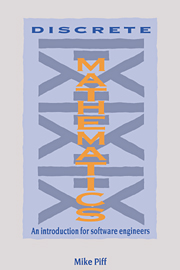6 - Graphs
Published online by Cambridge University Press: 05 June 2012
Summary
Introduction
The idea of a graph is one of the most elementary and simple in all of mathematics, yet the theory of graphs is remarkably complex, leading to both general theorems and to famous unsolved problems. We have met graphs already, in Chapters 4 and 5, where we used them to illustrate what was happening in a relation or mapping. In fact, we used directed graphs there, which are mathematically identical to binary relations.
There are also undirected graphs, which we shall meet for the first time in this chapter; they are broadly equivalent to symmetric relations. The structure of undirected graphs is simpler than that of directed graphs, leading to a rich and fruitful theory. There are complications inherent in the asymmetry of directed graphs which lead to a different sort of outlook, and a concentration on different kinds of problems.
Undirected graphs
The basic idea in an undirected graph is of a set of points called vertices joined by lines called edges. These points and edges could be thought of as nodes in an electrical network and wires joining them, or as road junctions and stretches of road between junctions. They could also be thought of as symmetric binary relations, where the vertices might be people, and an edge between two vertices might indicate that the people know one another. What is not sanctioned is the merging of two edges, the way two roads or flightpaths between cities might merge.
- Type
- Chapter
- Information
- Discrete MathematicsAn Introduction for Software Engineers, pp. 138 - 174Publisher: Cambridge University PressPrint publication year: 1991



